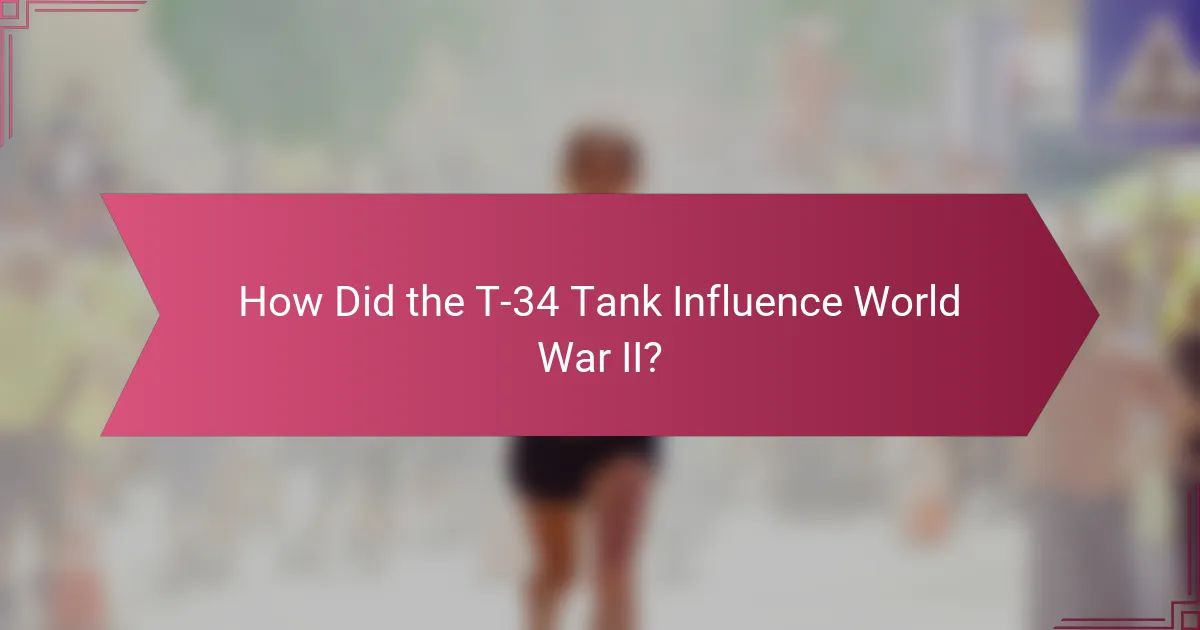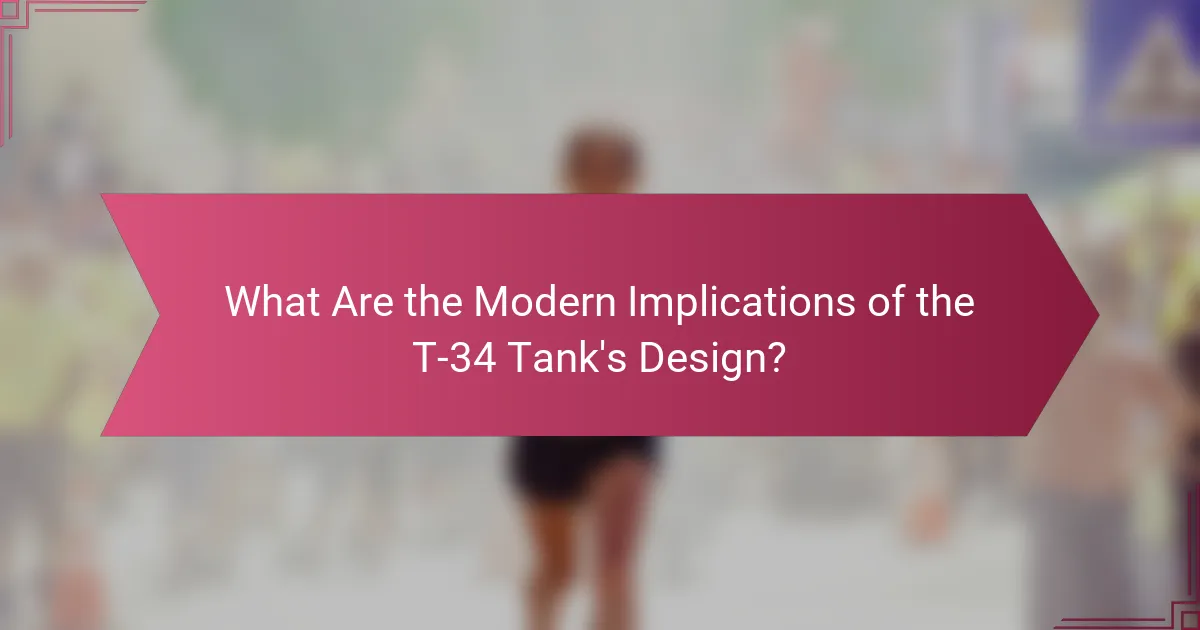The T-34 tank, developed during the late 1930s, revolutionized armored warfare with its innovative design and tactical advantages. Its exceptional blend of mobility, firepower, and armor not only made it a key asset for the Soviet Union during World War II but also influenced military strategies on both sides of the conflict.

What Are the Tactical Advantages of the T-34 Tank?
The T-34 tank offers several tactical advantages that significantly enhance its effectiveness on the battlefield. Its combination of mobility, armor, firepower, adaptability, and cost efficiency makes it a formidable asset in various combat scenarios.
Superior mobility
The T-34 is renowned for its superior mobility, allowing it to traverse diverse terrains with ease. Its wide tracks and powerful engine enable it to operate effectively in muddy or snowy conditions, which were common on the Eastern Front during World War II.
This mobility allows the T-34 to execute flanking maneuvers and reposition quickly, giving it an edge over less mobile tanks. Its speed can reach up to 55 km/h on roads, making it one of the fastest tanks of its time.
Effective armor design
The T-34 features a sloped armor design that enhances its defensive capabilities. This design increases the effective thickness of the armor, making it more resistant to enemy fire while reducing the likelihood of penetration.
With armor thickness ranging from 45 to 60 mm, the T-34 was able to withstand hits from many contemporary anti-tank weapons, providing a significant advantage in direct confrontations.
Versatile armament
The T-34 is equipped with a powerful 76.2 mm gun, which was effective against most enemy tanks during its early deployment. Later models upgraded to an 85 mm gun, further enhancing its firepower and versatility in combat.
This versatility allows the T-34 to engage a variety of targets, from infantry to armored vehicles, making it a well-rounded combat vehicle on the battlefield.
Operational adaptability
The T-34 was designed for operational adaptability, allowing it to be used in various roles beyond traditional tank warfare. It could serve as a command tank, recovery vehicle, or even as a platform for artillery support.
This adaptability enables commanders to deploy the T-34 in multiple scenarios, maximizing its utility across different combat situations.
Cost-effectiveness
The T-34 was relatively inexpensive to produce compared to other tanks of similar capability, making it a cost-effective option for the Soviet military. Its production costs were kept low due to efficient manufacturing processes and the use of readily available materials.
This cost-effectiveness allowed for mass production, resulting in thousands of units being deployed, which played a crucial role in the Soviet Union’s ability to sustain prolonged military engagements during the war.

How Did the T-34 Tank Influence World War II?
The T-34 tank significantly influenced World War II by introducing advanced design features and effective tactics that reshaped armored warfare. Its combination of firepower, mobility, and protection made it a formidable force on the battlefield, impacting both Soviet and Axis strategies.
Decisive battles
The T-34 played a crucial role in several key battles during World War II, including the Battle of Kursk and the Siege of Stalingrad. Its ability to traverse difficult terrain and engage effectively at various ranges allowed Soviet forces to exploit weaknesses in German defenses. The tank’s presence often shifted the momentum in favor of the Soviets, leading to significant victories.
In the Battle of Kursk, the largest tank battle in history, the T-34’s superior design and numbers contributed to a decisive Soviet victory, marking a turning point in the Eastern Front. This battle showcased the effectiveness of massed T-34 formations against German armor.
Shifts in tank warfare strategy
The introduction of the T-34 prompted a reevaluation of tank warfare strategies among both Soviet and German forces. Its sloped armor design and powerful 76.2 mm gun forced German commanders to adapt their tactics, often leading to the development of specialized anti-tank units and heavier tanks like the Panther and Tiger.
As the war progressed, the T-34’s influence encouraged the Soviets to adopt a more aggressive armored doctrine, emphasizing mobility and the use of combined arms. This shift allowed for rapid advances and encirclements, which became hallmarks of Soviet tactics.
Impact on Soviet military doctrine
The T-34 tank significantly shaped Soviet military doctrine by emphasizing the importance of mobility, firepower, and massed formations. Its success led to a focus on producing large quantities of reliable armored vehicles, which became a cornerstone of Soviet strategy throughout the war.
Additionally, the T-34’s design principles influenced post-war tank development and military thinking, reinforcing the idea that effective armor could be achieved through a balance of protection, firepower, and cost-efficiency. This legacy continued to inform Soviet and later Russian armored tactics for decades.

What Were the Key Development Phases of the T-34 Tank?
The T-34 tank underwent several critical development phases that shaped its design and operational effectiveness. From initial prototypes to mass production during World War II and subsequent modifications, each phase contributed to its status as a revolutionary armored vehicle.
Initial design and prototypes
The T-34’s initial design began in the late 1930s, focusing on a balance of firepower, armor, and mobility. The first prototypes were developed in 1939, featuring a 76.2 mm gun and sloped armor that enhanced its defensive capabilities. Early testing revealed the tank’s potential, leading to adjustments that improved its performance before mass production.
Production ramp-up during the war
As World War II intensified, the Soviet Union significantly increased T-34 production to meet battlefield demands. By 1941, factories were producing thousands of units monthly, with some estimates suggesting numbers in the tens of thousands by war’s end. This rapid ramp-up was facilitated by streamlined manufacturing processes and the use of readily available materials, allowing the T-34 to become a mainstay of Soviet armored forces.
Post-war modifications
After the war, the T-34 underwent various modifications to enhance its capabilities and adapt to new combat scenarios. These included upgrades to the armament, such as the introduction of the 100 mm gun in later models, and improvements in armor and mobility. The T-34 remained in service for decades, with many countries adopting it and making further modifications to suit their military needs.

What Are the Historical Contexts of the T-34 Tank?
The T-34 tank emerged during a pivotal time in military history, reflecting the Soviet Union’s strategic needs and technological innovations of the late 1930s. Its development was influenced by pre-war military strategies, advancements in tank technology, and the need to compete with other nations’ armored vehicles.
Pre-war Soviet military strategy
Before World War II, the Soviet military strategy emphasized rapid mechanization and mobility. The Red Army aimed to create a force capable of swift offensives, which necessitated a new type of tank that combined firepower, armor, and speed. This strategic focus led to the development of the T-34, which was designed to meet these operational demands.
Additionally, the Soviet Union sought to counter the perceived threats from Germany and other neighboring countries. The T-34’s design reflected a shift towards a more aggressive and mobile warfare approach, aligning with the broader military doctrine of deep battle, which aimed to penetrate enemy lines and disrupt their rear operations.
Technological advancements in the 1930s
The 1930s saw significant technological advancements that influenced the T-34’s design. Innovations in metallurgy allowed for the production of stronger and lighter armor, which enhanced the tank’s survivability without compromising mobility. The introduction of sloped armor design was particularly revolutionary, as it increased the effective thickness against enemy fire.
Moreover, advancements in engine technology provided the T-34 with a powerful diesel engine, enabling it to achieve higher speeds and better fuel efficiency compared to its predecessors. These technological improvements were crucial in making the T-34 a formidable opponent on the battlefield.
Comparison with contemporaneous tanks
When compared to contemporaneous tanks like the German Panzer III and the British Matilda, the T-34 stood out due to its combination of firepower, armor, and mobility. The T-34 was equipped with a 76.2 mm gun, which was more powerful than the armament of many of its rivals at the time, allowing it to engage enemy tanks effectively.
In terms of armor, the T-34’s sloped design provided superior protection, making it more resilient against hits. While the Panzer III had better optics and was more suited for reconnaissance, the T-34’s overall balance of features made it a versatile and effective tank in various combat scenarios.

What Are the Modern Implications of the T-34 Tank’s Design?
The T-34 tank’s design has significant modern implications, particularly in terms of armored warfare efficiency and adaptability. Its combination of firepower, mobility, and armor set a standard that continues to influence tank development today.
Lessons for contemporary armored vehicles
Contemporary armored vehicles can learn from the T-34’s emphasis on a balanced design that integrates firepower, protection, and mobility. Modern tanks should prioritize modularity, allowing for upgrades and modifications over time, similar to how the T-34 was adapted throughout its service life.
Additionally, the T-34’s sloped armor design effectively increased its survivability against various threats. Modern vehicles can benefit from similar geometric innovations that enhance protection while minimizing weight.
Influence on modern tank design
The T-34’s influence on modern tank design is evident in the adoption of composite materials and advanced armor technologies. Many current tanks incorporate features inspired by the T-34, such as improved turret designs and enhanced fire control systems.
Furthermore, the T-34’s operational success highlighted the importance of mobility on the battlefield. Modern tanks are increasingly designed to be faster and more maneuverable, allowing them to adapt to dynamic combat environments effectively.
